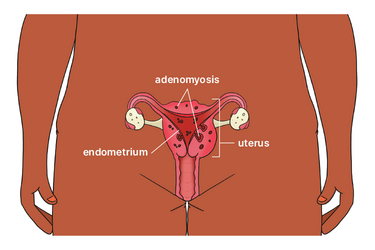On this page, you'll find information about adenomyosis, including the symptoms, causes and treatments.
What is adenomyosis?
How can adenomyosis affect periods?
Symptoms of adenomyosis
Causes of adenomyosis
How is adenomyosis diagnosed?
How does adenomyosis affect fertility?
Treatments for adenomyosis
When to see your doctor about adenomyosis
Related resources
Adenomyosis is a condition where cells similar to those that line the uterus are also in the muscle wall of your uterus.

Adenomyosis only affects women who have periods, particularly women aged 30 to 50. Studies suggest that about one in 5 women have adenomyosis.
You can have adenomyosis and endometriosis. With endometriosis, cells similar to those that line the uterus are found in other parts of your body, such as your fallopian tubes and ovaries.
With adenomyosis, the cells in your muscle wall bleed when you have your period. This can cause pain and other symptoms.
If you have adenomyosis, you might not have any symptoms. But about 2 in 3 women with adenomyosis experience:
We don’t know the exact cause of adenomyosis, but it may be associated with:
Adenomyosis can be hard to diagnose because there are no agreed tests to confirm the condition. Adenomyosis cannot be diagnosed from blood tests or tissue samples (biopsies).
If you think you might have adenomyosis, talk to your doctor. They will ask questions about your symptoms and may do a vaginal examination. If you have adenomyosis, your uterus might feel tender or enlarged.
Your doctor might refer you to a gynaecologist. Depending on your situation, they may do an internal ultrasound via the vagina to help diagnose the condition.
You may also need to have a magnetic resonance imaging (MRI) scan. This technology can be used to exclude other conditions, such as fibroids, and help diagnose adenomyosis.
A diagnosis of adenomyosis is usually only confirmed after the uterus has been removed (hysterectomy).
Adenomyosis can cause fertility problems because the condition makes it hard for an embryo to implant into the lining of the uterus. Adenomyosis can also cause pregnancy complications. Ask your doctor for more information.
Treatment for adenomyosis will depend on your symptoms, stage of life and whether you plan to have children.
Research shows a commonly used IUD has the best outcomes for managing symptoms of adenomyosis. The IUD is inserted into your uterus. It releases a hormone called progesterone which reduces bleeding and pain and thins the endometrial cells. You can have the IUD removed if you are planning a pregnancy.
The Pill may reduce bleeding and pain, but research suggests it is not as effective as an IUD. You can stop taking the Pill if you are planning a pregnancy.
Ask your doctor about the benefits and risks of each option.
Your doctor or specialist may not recommend surgery if you are planning a pregnancy. Surgery can result in scar tissue in the uterus, which might affect your fertility.
If you are not planning any future pregnancies, you can have an operation to remove the uterus lining (endometrial ablation) to reduce heavy bleeding. This operation may not reduce pain. You can have an endometrial ablation and use an IUD to help with symptoms.
If your symptoms are severe and you’re not planning future pregnancies, you can have surgery to remove your uterus (hysterectomy).
A non-surgical procedure called ‘uterine artery embolisation’ blocks blood supply to part of the uterus. This procedure reduces pain and bleeding, but it’s not recommended if you’re planning future pregnancies.
You can try things like gentle physical activity, meditation, yoga and acupuncture in addition to the above treatments to help manage your symptoms.
Talk to your doctor if your symptoms, such as painful periods, stop you from doing day-to-day activities.
This content has been reviewed by a group of medical subject matter experts, in accordance with Jean Hailes policy.
© Jean Hailes Foundation. All rights reserved.